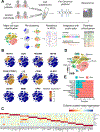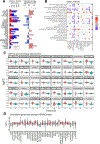Single-Cell Transcriptome Analysis Reveals Dynamic Cell Populations and Differential Gene Expression Patterns in Control and Aneurysmal Human Aortic Tissue
- PMID: 33017217
- PMCID: PMC7539140
- DOI: 10.1161/CIRCULATIONAHA.120.046528
Single-Cell Transcriptome Analysis Reveals Dynamic Cell Populations and Differential Gene Expression Patterns in Control and Aneurysmal Human Aortic Tissue
Abstract
Background: Ascending thoracic aortic aneurysm (ATAA) is caused by the progressive weakening and dilatation of the aortic wall and can lead to aortic dissection, rupture, and other life-threatening complications. To improve our understanding of ATAA pathogenesis, we aimed to comprehensively characterize the cellular composition of the ascending aortic wall and to identify molecular alterations in each cell population of human ATAA tissues.
Methods: We performed single-cell RNA sequencing analysis of ascending aortic tissues from 11 study participants, including 8 patients with ATAA (4 women and 4 men) and 3 control subjects (2 women and 1 man). Cells extracted from aortic tissue were analyzed and categorized with single-cell RNA sequencing data to perform cluster identification. ATAA-related changes were then examined by comparing the proportions of each cell type and the gene expression profiles between ATAA and control tissues. We also examined which genes may be critical for ATAA by performing the integrative analysis of our single-cell RNA sequencing data with publicly available data from genome-wide association studies.
Results: We identified 11 major cell types in human ascending aortic tissue; the high-resolution reclustering of these cells further divided them into 40 subtypes. Multiple subtypes were observed for smooth muscle cells, macrophages, and T lymphocytes, suggesting that these cells have multiple functional populations in the aortic wall. In general, ATAA tissues had fewer nonimmune cells and more immune cells, especially T lymphocytes, than control tissues did. Differential gene expression data suggested the presence of extensive mitochondrial dysfunction in ATAA tissues. In addition, integrative analysis of our single-cell RNA sequencing data with public genome-wide association study data and promoter capture Hi-C data suggested that the erythroblast transformation-specific related gene(ERG) exerts an important role in maintaining normal aortic wall function.
Conclusions: Our study provides a comprehensive evaluation of the cellular composition of the ascending aortic wall and reveals how the gene expression landscape is altered in human ATAA tissue. The information from this study makes important contributions to our understanding of ATAA formation and progression.
Keywords: aortic aneurysm, thoracic; mitochondria; sequence analysis, RNA; transcriptional regulator ERG.
Conflict of interest statement
Disclosures
The authors report no conflicts of interest. Dr. LeMaire serves as a consultant for Terumo Aortic and Baxter Healthcare; serves as a principal investigator for clinical studies sponsored by Terumo Aortic and CytoSorbants; and serves as a co-investigator for clinical studies sponsored by W.L. Gore & Associates.
Figures





References
-
- Goldfinger JZ, Halperin JL, Marin ML, Stewart AS, Eagle KA, Fuster V. Thoracic aortic aneurysm and dissection. J Am Coll Cardiol. 2014;64:1725–1739. - PubMed
-
- Kolodziejczyk AA, Kim JK, Svensson V, Marioni JC, Teichmann SA. The technology and biology of single-cell RNA sequencing. Mol Cell. 2015;58:610–620. - PubMed
Publication types
MeSH terms
Grants and funding
LinkOut - more resources
Full Text Sources
Molecular Biology Databases

